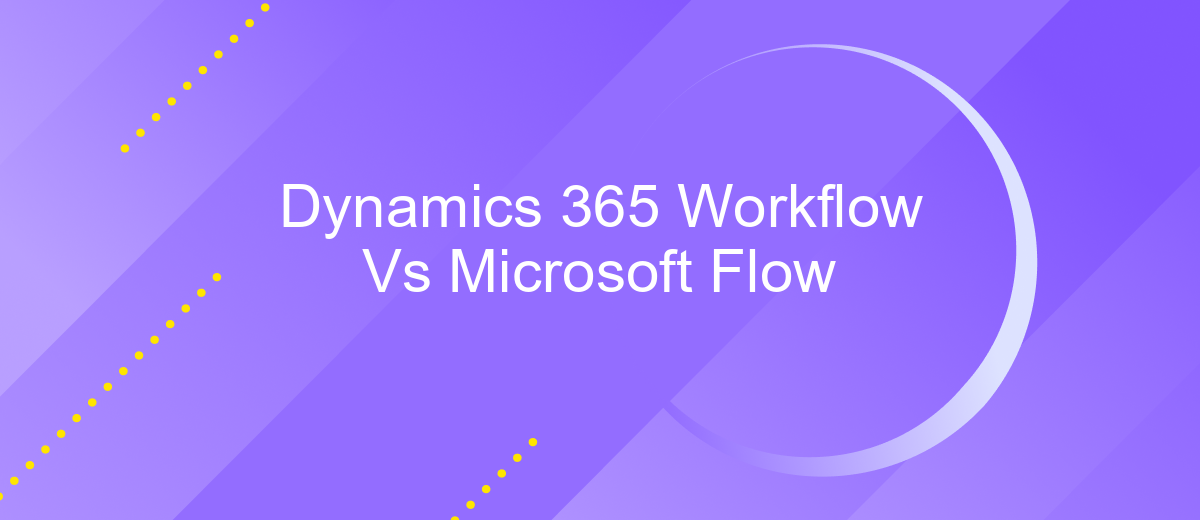Dynamics 365 Workflow Vs Microsoft Flow
In the rapidly evolving landscape of business automation, Dynamics 365 Workflow and Microsoft Flow (now Power Automate) stand out as powerful tools for streamlining processes. This article explores the key differences, strengths, and use cases of each platform, helping organizations determine which solution best fits their unique needs and enhances their operational efficiency.
Introduction
In today's rapidly evolving business environment, automating workflows and streamlining processes is crucial for maintaining efficiency and competitiveness. Dynamics 365 Workflow and Microsoft Flow (now known as Power Automate) are two powerful tools designed to help organizations achieve this goal. Both platforms offer unique features and capabilities, making it essential to understand their differences and determine which one best suits your needs.
- Dynamics 365 Workflow: A robust tool integrated within the Dynamics 365 suite, designed for automating business processes directly within the CRM.
- Microsoft Flow (Power Automate): A versatile automation service that connects various applications and services to automate workflows across different platforms.
Choosing between Dynamics 365 Workflow and Microsoft Flow depends on your specific requirements and business goals. Dynamics 365 Workflow is ideal for those heavily invested in the Dynamics ecosystem, while Microsoft Flow offers broader integration capabilities, including third-party services like ApiX-Drive, which simplifies the process of connecting various applications. By understanding the strengths and limitations of each tool, you can make an informed decision and enhance your organization's productivity.
Dynamics 365 Workflow

Dynamics 365 Workflow is a powerful tool within the Dynamics 365 suite that allows users to automate business processes without writing code. It provides a range of predefined actions and conditions that can be used to create complex workflows. These workflows can be triggered by various events, such as record creation or updates, ensuring that tasks are executed automatically. This not only enhances efficiency but also reduces the possibility of human error, making it an invaluable asset for businesses looking to streamline their operations.
One of the key features of Dynamics 365 Workflow is its seamless integration capabilities. Users can easily connect with other services and applications to further extend the functionality of their workflows. For instance, utilizing a service like ApiX-Drive can simplify the integration process by providing a user-friendly interface to connect Dynamics 365 with various third-party applications. This allows for a more cohesive and automated business environment, where data flows smoothly between systems, enhancing overall productivity and operational efficiency.
Microsoft Flow

Microsoft Flow, now known as Power Automate, is a cloud-based service that allows users to create automated workflows between their favorite apps and services. It is designed to help users streamline repetitive tasks and business processes without the need for extensive coding knowledge. Power Automate integrates seamlessly with a wide range of Microsoft and third-party applications, making it a versatile tool for enhancing productivity.
- Automate tasks and processes with a visual designer.
- Connect to over 300 data sources, including Microsoft 365, SharePoint, and Dynamics 365.
- Utilize pre-built templates for common workflows.
- Implement conditional logic to create complex workflows.
- Monitor workflow performance with built-in analytics.
One of the key advantages of Power Automate is its ability to integrate with various services through connectors. For instance, ApiX-Drive offers a robust solution for setting up integrations between different platforms, enhancing the capabilities of Power Automate. By leveraging these integrations, businesses can automate data transfers, synchronize information across systems, and improve overall operational efficiency.
Comparison

Dynamics 365 Workflow and Microsoft Flow are both powerful tools designed to automate business processes, but they serve slightly different purposes. Dynamics 365 Workflow is deeply integrated into the Dynamics 365 ecosystem, making it ideal for automating tasks within the Dynamics 365 environment. Microsoft Flow, now known as Power Automate, offers a broader range of integrations with various Microsoft and third-party applications.
When considering which tool to use, it's essential to understand your specific needs. Dynamics 365 Workflow is perfect for users who require complex, conditional logic within Dynamics 365. On the other hand, Power Automate excels in scenarios where you need to connect multiple services and automate workflows across different platforms.
- Integration: Power Automate supports a wide range of integrations, including non-Microsoft services like ApiX-Drive, making it versatile for diverse business needs.
- Ease of Use: Power Automate offers a user-friendly interface with drag-and-drop functionality, whereas Dynamics 365 Workflow requires more technical expertise.
- Customization: Dynamics 365 Workflow provides robust customization options within the Dynamics 365 environment.
In conclusion, the choice between Dynamics 365 Workflow and Power Automate depends on the scope and complexity of your automation needs. For seamless integration within Dynamics 365, the Workflow is the better choice. However, for broader, cross-platform automation, Power Automate, with its extensive integrations, including ApiX-Drive, is more suitable.
Conclusion
In conclusion, both Dynamics 365 Workflow and Microsoft Flow offer robust solutions for automating business processes, but they cater to different needs and use cases. Dynamics 365 Workflow is tightly integrated with the Dynamics 365 ecosystem, making it ideal for complex, organization-specific workflows that require deep customization within the Dynamics environment. On the other hand, Microsoft Flow, now known as Power Automate, provides a more flexible, user-friendly approach that supports a wide range of third-party applications and services, making it suitable for broader integration scenarios.
For businesses looking to streamline integrations and automate workflows across various platforms, services like ApiX-Drive can be invaluable. ApiX-Drive offers a seamless way to connect multiple applications without requiring extensive coding knowledge, thus complementing the capabilities of both Dynamics 365 Workflow and Microsoft Flow. Ultimately, the choice between these tools should be based on the specific requirements and existing infrastructure of your organization, ensuring that you leverage the strengths of each to achieve optimal efficiency and productivity.
FAQ
What is the main difference between Dynamics 365 Workflow and Microsoft Flow?
Can Dynamics 365 Workflow be used to integrate with external applications?
Can Microsoft Flow be used to automate tasks within Dynamics 365?
Which tool is easier to use for non-developers, Dynamics 365 Workflow or Microsoft Flow?
What are some alternatives for integrating and automating workflows outside of Dynamics 365 and Microsoft Flow?
Do you want to achieve your goals in business, career and life faster and better? Do it with ApiX-Drive – a tool that will remove a significant part of the routine from workflows and free up additional time to achieve your goals. Test the capabilities of Apix-Drive for free – see for yourself the effectiveness of the tool.

